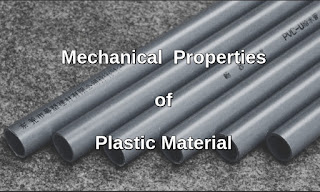NON - METALLIC METERIALS :
These are used in engineering practice due to their low density, low cost. flexibility, resistant to heat and electricity.
1. PLASTICS :
These are synthetic materials which are moulded into shape under pressure with ar without the application of heat. These can also be cast, rolled, extruded, laminated and machined.
TYPES OF PLASTICS
(i). Thermosetting plastics :
The thermosetting plastics are those which are formed into shape under heat and pressure and results in a permanently hard product. The heat first softens the material, but as additional heat and pressure is applied, it becomes hard by a chemical chenge called phenol-formaldehyde (Bakelite), phenol-furfural (Durite), urea-formaldehyde (Plaskon), ete.
(ii). Thermoplastic :
The thermoplastic materials do nut becume hard with the application of heat and presure and no chemical change occurs. They remain soft at elevated temperatures until they are hardened by cooling These can he remelted repeatedly by successive application of heat. common thermoplastics are Cellulose nitrate (Celluloid), polythene, polyvinyl acetate. polyvinyl chloride (P.V.C.) ete. The plasties are extremely resistant to corrosion and have a high dimensional stability.
Uses :
(a). manufacture of aeroplane and automobile parts.
(b). For making safety glasses, laminated gears, pulleys, self-lubricnting bearing etc., due to their resilience and strength.
Polymers : Most solid substances-metals, salta and minerals-exist in a purely crystalline form, i.e. atoms or ions of which they are compused are arranged in some regular geometric pattern. This is generally possible because atoms (or ions) are small and very easily maneouorable. In polymers, large molecules entangle with each other and are consequently much less, man manoeuvrable.
As a result only a limited degree of crystalline arrangement is possible with most polymers as they cool, and only restricted regions occur in which the linear molecular chains arrange themselves in an ordered pattern. These ordered regions are called crystallites.
Thus in a solid state, polymers consist of both crystalline and amorphous regions. Highly crystalline polymers contain up to 90 crystalline regions whilst others are almost completely amorphous.
Melting Point of Polymers :
Amorphous and crystalline plastics materials on heating become progressively less rigid and show no clear transition from solid to liquid, since amorphous become less viscous as the temperature rises. In highly crystalline polymers, a sudden change in the rate of expansion oceurs on heating to a certain temperature. At this point all crystalline regions have become amorphous when solid crystalline metals change to amorphous liquids. In plastic materials this is designated as melting point (T). Greater the degree of crystallinty of polythene, the higher its melting point, Because Vander waal's forces are much greater in the crystalline regions since the molecules are closer together there.
Glass Transition Temperature :
At ambient temperature polymers may be either soft and flexible or hard, brittle and glassy. The temperature at which this soft- to- glassy change is called glass-transition tempretempe Tg.
Vicat Softening Temperature :
It offers a useful means of compnrisom between plastic materials as far as their resporise to temperature change is concerned.It measures temperature at which a standard indentor penetrates a specific distance into the surfaçe of the plastics material using a standard force. During the test, temperature is raised at specified uniform rate and penetration (usually 1 mm) has been attained.
Mechanical properties of plastic materials:
The strength of plastics materials is generally much lower than that of most other constructional materials. Nevertheless plasties are light materials with a relative density botween 0.9 and 2.0 so that when considered in terms of strength/weight ratio they compare favourably with some motals and alloys.
The Maechanical properties of most engineering metals and alloys very very little within the range of ambient temperature encountered in service. This is expected since na structural changes occur until the recrystallisation temperalure is reached and this is usually well ubove 100°C. With many polymer-particularly thermoplastic-malerials, mechanical properties vary Considerably with temperature in the ambient region. Both Tm and Tg will affect mechanical propertios as will the gradual reduction in Van der Waals' forces with rise in temperature. Thus a thermoplastic polymer may have a tensile strength of say, 70 N/mm^2 at 0°C aling to 40 N/mm^2 at 25°C, and to no mare than 10 N/mm^2 at 80°C. As tensile strength falls rise in temperatur there is a corresponding increase in % elongation.
2. Rubber
It is one of the most important natural plastics. It resists abrasion, heat, strong alkalis and fairly strong acids. Soft rubber is used for electrical insulations. It is also used for power transmission belting, being applied to woven cotton or cotton cords as a base.
Uses : Hard rubber is used for piping and as lining for pickling tanks.
3. Leather
Itis very flexible and can withstand considerable wear under suitable conditions.
Uses : For power transmission belting and as a packing or as washers.
4. Ferrodo
It is a trade name given to asbestos lined with lead oxide.
Uses : As a friction lining for clutches and brakes.
Writer - Sk Najmul . ( munna )



0 comments:
Post a Comment
Please do not enter any spam link in the comment box.